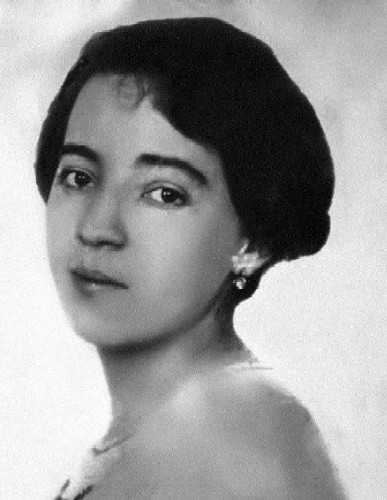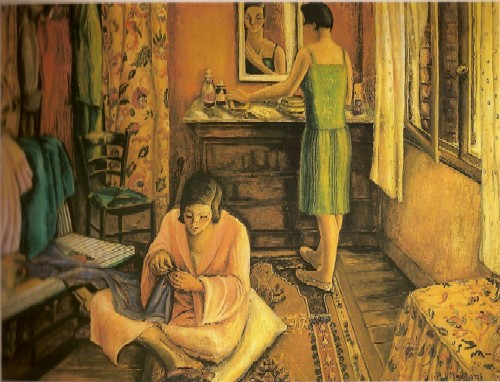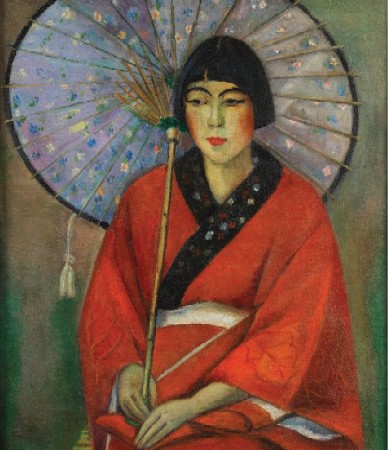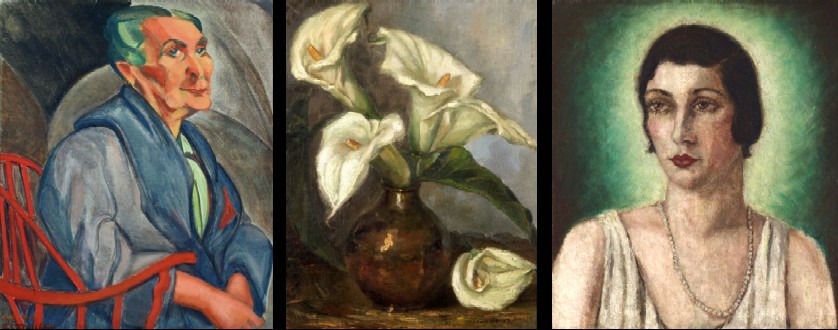
Anita Malfatti (1889 - 1964)
Anita Catarina Malfatti was a Brazilian artist who created Modernist

Anita Malfatti, 1912
art at a time when much of the Brazilian society members still considered traditional artist styles such as romanticism and realism appropriate. She is so associated with the style in that country that she is usually considered the person who introduced the European and American style Modernist artwork to Brazil.
Malfatti was born in São Paulo to an Italian father and American mother with atrophy of her right hand. She was sent to Lucca, Italy to have it corrected, but failed to recover its full use. Being exposed to art at an early age by her artist mother, Anita became interested in creating art. She learned to draw with her left hand under the guidance of American teacher Marcia Brown to compensate for her atrophied hand. In 1897 she attended Externato São José learning to read and write. She went to Escola Americana in 1903, and shortly after at Mackenzie College in São Paulo, where, in 1906, she received her diploma as a teacher.
With the help of her godfather, Malfatti left Brazil to study in Germany in 1910. She was first tutored by Fritz Burger for six months at his studio after which she enrolled in the Royal Academy of Fine Arts in Berlin. She quit the school after the first year upon finding that the academic style didn't interest her. She took classes with painter Lovis Corinth who ran a school for women. Here she discovered the Expressionist style of painting. In 1913, she began classes with Professor Ernst Bischoff-Kulm where she was learned about Cubism. Anita found the Cubist images at the Sonderbund exhibition in Cologne in 1912 particularly interesting.
With World War I looming, Malfatti returned to Brazil in 1914. Hoping return to Europe and study in Paris, she organized an exhibition of her expressionist art in 1914 with the goal of obtaining a scholarship. Her style put off the traditionalists in charge of the scholarship, so her turned to her godfather for help. He financed her travel to New York where she enrolled in the Art Student's League in early 1915, studying printmaking and painting. She later enrolled in the Independent School of Art where she met several European artists and studied under American artist Homer Dean Boss.
Homer Boss was a huge impact on Malfatti's style because of his comprehensive studies of the human anatomy. He stressed the idea of understanding the muscular body which helped Malfatti to hone her own technique.

La Rentree (Back to School), 1927, Daily Art Magazine
...Malfatti's exposure to the European world of art allowed her a glimpse into an artistic world that she could never have known in São Paulo and gave her the more global viewpoint that she would pass on to other artists as well." ("Anita Malfi", English Wikipedia website, gathered 9/9/24)
Malfatti returned to Brazil in mid-1916. She held a second exhibition of her artwork in December of 1917, hoping that her avant-garde paintings would be embraced by the public. "Although Malfatti carefully chose her artworks so as not to offend—for example, she omitted her nudes from the exposition—her work was still highly criticized. In New York she had been heralded as another member of the avant-garde artists, but in Brazil her art was not recognized to be a positive contribution in the important search of nationalism and traditions within art." ("Anita Malfi", English Wikipedia) "Many of her works were returned, while others were nearly destroyed. Anita sank into depression and isolated herself from everyone." ("Anita Malfi", Brazilian Wikipedia website, gathered 9/9/24) To earn a living she painted in the workshop of academic artist Pedro Alexandrino and taught at Mackenzie University and the Women's Civic Association.
The hidebound reaction to her exhibition caused other progressive Brazilian artists and intellectuals to search for a way to bring modern art to Brazilian. Poet and critic Oswald de Andrade was inspired to served organize the

The Japanese Woman, 1924, Google Arts and Culture
Semana de Arte Moderna (Modern Art Week) exhibition in February of 1922, prominently featuring Malfatti's artwork, among several other Brazilian avant-garde artists. The Modernist-oriented Grupo dos Cinco (Group of Five) coalesced around this event, initially including Malfatti, poet Menotti Del Piccia, poet and author Mario de Andrade and Oswalde de Andrade. The fifth member, painter Tarsila do Amaral, was in Paris when the exhibition took place, but upon her return to Brazil three months after the event joined the group.
Malfatti received a scholarship from the Pensionato Artístico do Estado de São Paulo (Artistic Pension of the State of São Paulo) in 1922. The program was created to promote Brazilian artistic development by sending talented artists to Rome or Paris to study. She spent five years in Paris and the city of Luz, where she met artists like Cubist Fernand Leger and Fauvist Henri Matisse. Her style became more traditional and less Cubist and the colors used became somewhat more muted, likely in response to the poor reception of her 1917 exhibition. Yet her paintings were still very much in keeping with the European Modernist style of that time. She exhibited her work in a variety of Parisian galleries and salons beginning in 1924.
Upon returning to Brazil in 1928, Malfatti found the that artistic environment was more open to avant-garde art. Fellow Grupo dos Cinco member Tarsila do Amaral had produced paintings during this period in an effort to find a way to blend the European Modernism with the local landscapes and culture of Brazil. Anita Malfatti held a solo exhibition in São Paulo in 1929. She resumed teaching at Escola Normal Americana and Escola Normal do Mackenzie College. She set up a studio in 1932 which remained open until 1952. She was elected president of the Union of Plastic Artists of São Paulo in 1940, exhibiting her works at the Art Museum of São Paulo in 1949. She participated in the first Bienal de São Paulo in 1951.
Sources Not Cited Above:
Lucia Pesapane, "Anita Malfatti", Aware Women Artists Website, gathered 9/9/24
Rue Ferreira, "Anita Malfatti: The First Modernist of Brazil", Daily Art Magazine Website, gathered 9/9/24
"Anita Malfatti", Sketchline Website, gathered 9/9/24
"Anita Malfatti", Art Sphere Inc. website, gathered 9/9/24
Ana Paula Cavalcanti Simioni, "Primitivism in Dispute: Production and Reception of the Works of two Brazilian Artists in Paris in the 1920s", Modernism Modernity website, gathered 9/9/24
Original Facebook Group Profile
 Anita Malfatti Paintings, From Left: Old Woman with Green Hair, 1916; Vaso de Flores, undated; Portrait of Baby de Almeida, 1930.
Anita Malfatti Paintings, From Left: Old Woman with Green Hair, 1916; Vaso de Flores, undated; Portrait of Baby de Almeida, 1930.